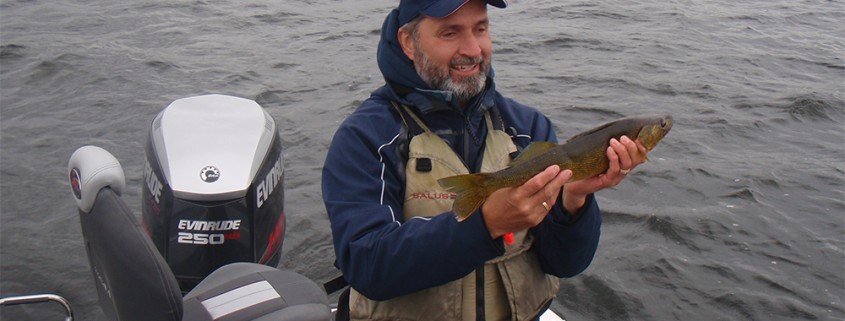Origins and current Applications of The Hunter-Gatherer Jig Angler
Ever wonder where the term “Jig” came from? Hunter-gatherers have been fashioning fish attractors using feathers and fur for thousands of years. These artificial baits would be jiggled on the end of a short strand of catgut. Fish that drew near to investigate would be speared. It wasn’t until much later that hooks were introduced. Early hooks were assembled with several fine bones or thorns tied together in the shape of a “V”. The use of various metals to add weight and flash came much later. Interesting to note, it was primarily women who did much of the early jigging and spearing of fish.
Jigs may seem simple in concept, but the myriad ways they can be dressed and used are countless. From size, weight, shape, colour and the use of hair, feather or plastic attractors, all manner of adornments have been added to enhance their appearance. The endless variety of jig configurations can now make the task of picking one over another daunting.
Just as one wouldn’t use a hammer for every repair job around the house, jig style and presentation method differ widely according to circumstance. The following factors need to be considered when selecting the ideal jig for a specific application. Consider: water clarity, light levels, local forage, current and depth, fish temperament, time of year, and fish habitat and structure.
The kick I get from buying new tackle still boosts my spirits. However, experience and a sore shoulder has taught me well to avoid the temptation of preparing for all conceivable scenarios, as it only leads to a seriously over-weighted tackle bag. Jigs may be small, but in no time can add up to be quite the “boat anchor”.
An easy way to keep a lid on over-stocking jigs is to limit purchases to a handful of colours. Instead of matching every conceivable hatch, go with natural colours for applications in open and relatively clear water, Black with a touch of something more vibrant for low light or heavily stained conditions, and rattles only for low visibility situations. Colour is often the least most important factor. Well-loved jig heads pounded virtually free of paint still often get the job done.
To avoid falling into the trap of becoming a “Jack of all trades and a master of none”, take the time to learn how to present jigs under different conditions. Presentation styles range widely from a simple lift and drop to sudden rips, and everything in between including: dragging, dead sticking, swimming, snapping, popping and twitching. Jigs can be fished directly below the boat or through a hole in the ice, pitched / flipped around visible cover, or fished blind by long-bombing them into open water.
More vigorous horizontal retrieve techniques meant to quickly cover aquatic territory have me reaching for outfits spooled with fluorocarbon line and fast action rods. fluoro sinks the fastest of all lines, and provides the straightest possible connection between the rod tip and your jig.
Deeper more vertical and slower presentation styles that demand rapid and instant hook sets increase the need for feeling subtle bites. Shorter extra-fast rods spooled with braid get the nod. The non-stretch properties of braid give a direct tactile connection to the jig below the boat / ice.

Lawrence holding 2 bass caught while fishing on White Lake
Ultra-light applications generally mean close-in work; making cheaper monofilament lines perfectly acceptable. Micro jigs used with ultralight outfits haven’t the weight to influence line stretch or sink rate, and even a basic ultralight rod will be able to transmit subtle bites without line stretch interfering. Besides, the bit of stretch in 2 or 4 lb line gives that added insurance against breakage.
In general, jig-rod actions almost always lean towards extra fast of whatever power will get the job done. The soft tip aids in detecting bites without imparting unnatural tension to the fish. It just doesn’t feel right to fish when tasting or feeling small bits of potential food with their mouths to encounter resistance associated with something far larger. Jig rods should also have a stiffer backbone ¾ up the blank for hook setting and to turn fleeing fish before they exhaust themselves beyond recovery.
A fast or moderate fast rod comes into play when actively swimming jigs horizontally. Fish first swipe at fleeing pray before making it a meal. The first strike is meant to disable the pray. The second and third strikes are signs of the fish actually eating. A rod with some give allows the jig to be slowed significantly by the first bite without it moving forward as if it possessed bionic strength.
The correct weight of a jig for each application is determined by current or drift speed. Generally, fishing as close to vertical is preferable as it affords maximum control over the jig without having to worry about dragging the lure into snaggy structure, or conversely, the jig drifting harmlessly just feet below the surface.
Penetrating heavy structure calls for heavier weights, as does clear warmer water. The first to break through to where the fish are residing, and the second to tempt active fish into reacting quickly without first having the opportunity to thoroughly size-up your offering.
Under almost all conditions fish will strike a jig as it’s dropping on a slack line. Too much tension, or any tension for that matter, will cause the jig to pendulum back towards the angler as it sinks; imparting the jig an unnatural look.
As a person who SCUBA’s I’m constantly reminded just how little cover there is in vast areas of lakes and rivers. It’s still possible to find fish in these open areas, but count on them being in continual movement. They expect their pray to be doing the same. When fishing over structure slow it down and even pause, but when the lack of tactile feedback from your rod is telling you there’s not much down there, keep moving to improve your odds of crossing paths with actively feeding fish.
Lastly, retrieving a jig back to the boat may seem simple enough, but requires the application of basic geometry. The following holds true whether snapping, jigging or swimming jigs horizontally.
A jig cast out and then raised with the rod tip is going to have more forward momentum than vertical lift. Dropping the rod tip the same amount you just raised it isn’t necessary. Follow the jig down by getting to know the sink rate, and then repeat the motion just slightly ahead of the jig to avoid line tension. As the jig draws closer, use less lift and more follow. By shortening the degree of lift with each stroke, your jig will exhibit a more consistent retrieve profile. By the time the jig arrives directly below, the movement of the rod tip on the lift and drop should be the same. This way when you do get bit you will know exactly how far your jig was above bottom at the time; allowing you to dial in your retrieve and eliminate waste.
Watching your rod tip to maintain a steady retrieve will work against you. Close your eyes and try visualizing what the fish are seeing. Do this, and I’ll guarantee you will become far more adept at imparting a consistent retrieve, even if others observe the movement of your rod as changing with every stroke.
The evolution of jig fishing in the past 100 years is truly impressive. While the concept may seem simple and traditional, learning to fish jigs effectively under a wide variety of conditions has become an art in itself. Take the time to expand your jig fishing skills and embrace a tradition that goes back thousands of years.



